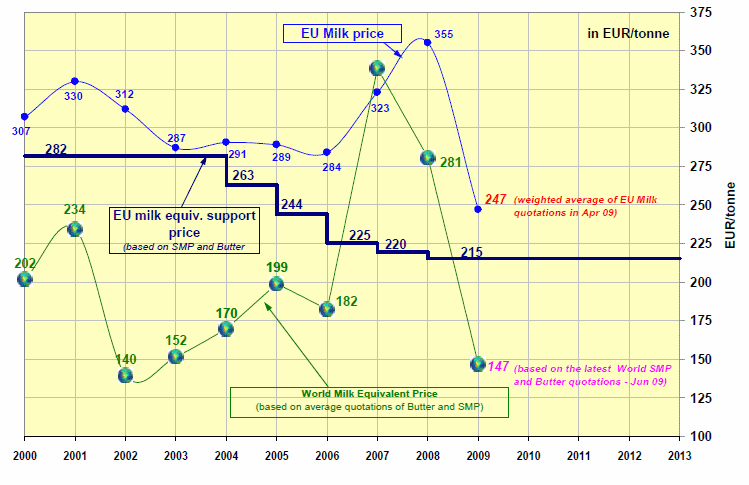The Commission today produced its report on the dairy market requested by the European Council in June, and Commissioner Fisher Boel has underlined its main findings in her blog. The background to the current market crisis is shown clearly in the graph reproduced from the Commission report.

The report first makes a convincing case that the collapse in milk prices has nothing to do with the relaxation of EU dairy quotas as part of the ‘soft landing’ to their elimination in 2015. For the first point, EU milk production actually fell by 0.9% in the marketing year 2008/09 despite the 2-2.5% increase in quotas. The real sources of the crisis are the weakness of global demand and a powerful surge in output from major non-European producers.
Thus the Commission refuses to reverse its policy to gradually increase quotas in order to reduce quota rents to zero by the time the quota policy is eliminated in 2015. This is a direct response to the demand by the new dairy farmer lobby group European Milk Board for the limitation of quotas in order to manage supply.
However, the second point made by the report, and emphasised by the Commissioner in her blog, is that phasing out quotas does not mean that dairy farmers have been left completely to the mercies of the free market. The EU has made use of its traditional instruments of market management, including public intervention, aids for private storage, and export refunds. Export refunds for butter, for example, at the beginning of July were €650 per tonne, compared to a world market price (based on Oceania quotations) of €1,348 per tonne.
Also, part of the reduction in milk prices at farm level was compensated in the 2003 CAP reform by an increase in direct payments worth around 3.5c/litre.
The report also highlights various options open to Member States to support dairy farmers through the CAP Health Check reforms of the national envelope, the use of modulated rural development funds and the use of money from the European Economic Recovery Programme.
Despite these measures, however, it is clear that European dairy farmers are hurting. At the same time, there is little evidence that European consumers are benefiting in terms of lower consumer prices for dairy products. Figures in the annex to the report show that despite a reduction in the farmgate price of milk of 28% between Q4 of 2007 and Q1 of 2009, the price of the food category ‘milk, cheese, eggs’ (which includes other milk products but excludes butter) increased by 4%, with higher increases in some Member States. The pattern is similar across most Member States and strongly suggests the exercise of market power by retailers in the dairy supply chain.

